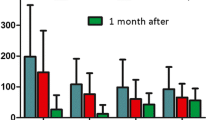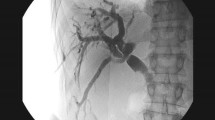Abstract
Purpose
To determine the safety and efficacy of percutaneous intraductal radiofrequency ablation (RFA) combined with biliary metal stent placement for patients with unresectable malignant biliary obstruction.
Methods
From a cohort of 70 patients with unresectable malignant biliary obstruction, 28 patients received percutaneous intraductal RFA combined with biliary stent placement (group A) and the remaining 42 were treated with biliary metal stent placement only (group B). Stent patency, overall survival (OS), alleviation of jaundice, and postoperative complications were assessed.
Results
The technical success rate for both groups was 100%. No severe complications (e.g., biliary bleeding, perforation) occurred. In both groups, jaundice was relieved and the decrease of the total and direct bilirubin concentration was significant (p < 0.01). The median time of stent patency in group A and group B were 6.6 ± 0.3 months (95% CI 6.1–7.1 months) and 4.9 ± 0.4 months (95% CI 4.2–5.6 months), respectively (p < 0.01). The median overall survival times in Group A were 7.2 ± 0.3 months (95% CI 6.5–7.9 months) versus 5.6 ± 0.4 months (95% CI 4.8–6.4 months) in group B (p < 0.01). In univariate and multivariate analyses, intraductal RFA, stent patency, and decreased baseline serum direct bilirubin concentration were associated with greater OS (p < 0.05).
Conclusion
Percutaneous intraductal RFA combined with stent placement is a safe and effective method for patients with malignant biliary obstruction. As compared to stent placement alone, percutaneous intraductal RFA can significantly prolong stent patency and improve the overall survival of patients with malignant biliary obstruction.




Similar content being viewed by others
References
Mensah ET, Martin J, Topazian M (2016) Radiofrequency ablation for biliary malignancies. Curr Opin Gastroenterol 32 (3):238-243. https://doi.org/10.1097/MOG.0000000000000258
Auriemma F, De Luca L, Bianchetti M, Repici A, Mangiavillano B (2019) Radiofrequency and malignant biliary strictures: An update. World J Gastrointest Endosc 11 (2):95-102. https://doi.org/10.4253/wjge.v11.i2.95
Das A, Sivak MV, Jr. (2000) Endoscopic palliation for inoperable pancreatic cancer. Cancer Control 7 (5):452-457. https://doi.org/10.1177/107327480000700508
Kahaleh M, Tokar J, Conaway MR, Brock A, Le T, Adams RB, Yeaton P (2005) Efficacy and complications of covered Wallstents in malignant distal biliary obstruction. Gastrointest Endosc 61 (4):528-533.
Gervais DA, Goldberg SN, Brown DB, Soulen MC, Millward SF, Rajan DK (2009) Society of Interventional Radiology position statement on percutaneous radiofrequency ablation for the treatment of liver tumors. J Vasc Interv Radiol 20 (7 Suppl):S342-347. https://doi.org/10.1016/j.jvir.2009.04.029
Wu TT, Li HC, Li WM, Ao GK, Lin H, Zheng F, Song JY (2015) Percutaneous Intraluminal Radiofrequency Ablation for Malignant Extrahepatic Biliary Obstruction: A Safe and Feasible Method. Dig Dis Sci 60 (7):2158-2163. https://doi.org/10.1007/s10620-015-3547-6
Dolak W, Schreiber F, Schwaighofer H, Gschwantler M, Plieschnegger W, Ziachehabi A, Mayer A, Kramer L, Kopecky A, Schrutka-Kolbl C, Wolkersdorfer G, Madl C, Berr F, Trauner M, Puspok A (2014) Endoscopic radiofrequency ablation for malignant biliary obstruction: a nationwide retrospective study of 84 consecutive applications. Surg Endosc 28 (3):854-860. https://doi.org/10.1007/s00464-013-3232-9
Laquiere A, Boustiere C, Leblanc S, Penaranda G, Desilets E, Prat F (2016) Safety and feasibility of endoscopic biliary radiofrequency ablation treatment of extrahepatic cholangiocarcinoma. Surg Endosc 30 (3):1242-1248. https://doi.org/10.1007/s00464-015-4322-7
Li TF, Huang GH, Li Z, Hao CF, Ren JZ, Duan XH, Zhang K, Chen C, Han XW, Jiao DC, Zhang MF, Wang YL (2015) Percutaneous transhepatic cholangiography and intraductal radiofrequency ablation combined with biliary stent placement for malignant biliary obstruction. J Vasc Interv Radiol 26 (5):715-721. https://doi.org/10.1016/j.jvir.2015.01.037
Wu TT, Li WM, Li HC, Ao GK, Zheng F, Lin H (2017) Percutaneous Intraductal Radiofrequency Ablation for Extrahepatic Distal Cholangiocarcinoma: A Method for Prolonging Stent Patency and Achieving Better Functional Status and Quality of Life. Cardiovasc Intervent Radiol 40 (2):260-269. https://doi.org/10.1007/s00270-016-1483-2doi:
Ma J, Luo J, Gu J, Liu Q, Liu L, Zhang W, Zhang Z, Yan Z (2018) Malignant obstructive jaundice treated with intraluminal placement of Iodine-125 seed strands and metal stents: An analysis of long-term outcomes and prognostic features. Brachytherapy 17 (4):689-695. https://doi.org/10.1016/j.brachy.2018.04.001
Chen AP, Setser A, Anadkat MJ, Cotliar J, Olsen EA, Garden BC, Lacouture ME (2012) Grading dermatologic adverse events of cancer treatments: the Common Terminology Criteria for Adverse Events Version 4.0. J Am Acad Dermatol 67(5):1025–1039. https://doi.org/10.1016/j.jaad.2012.02.010
Andersen JR, Sorensen SM, Kruse A, Rokkjaer M, Matzen P (1989) Randomised trial of endoscopic endoprosthesis versus operative bypass in malignant obstructive jaundice. Gut 30 (8):1132-1135
Shepherd HA, Royle G, Ross AP, Diba A, Arthur M, Colin-Jones D (1988) Endoscopic biliary endoprosthesis in the palliation of malignant obstruction of the distal common bile duct: a randomized trial. Br J Surg 75 (12):1166-1168
Zhu HD, Guo JH, Huang M, Ji JS, Xu H, Lu J, Li HL, Wang WH, Li YL, Ni CF, Shi HB, Xiao EH, Lv WF, Sun JH, Xu K, Han GH, Du LA, Ren WX, Li MQ, Mao AW, Xiang H, Zhang KX, Min J, Zhu GY, Su C, Chen L, Teng GJ (2018) Irradiation stents vs. conventional metal stents for unresectable malignant biliary obstruction: A multicenter trial. J Hepatol 68 (5):970–977. https://doi.org/10.1016/j.jhep.2017.12.028
Miyayama S, Matsui O, Terayama N, Tatsu H, Yamamoto T, Takashima T (1997) Covered gianturco stents for malignant biliary obstruction: preliminary clinical evaluation. J Vasc Interv Radiol 8 (4):641-648. https://doi.org/10.1016/s1051-0443(97)70624-9
Han YM, Jin GY, Lee SO, Kwak HS, Chung GH (2003) Flared polyurethane-covered self-expandable nitinol stent for malignant biliary obstruction. J Vasc Interv Radiol 14 (10):1291-1301. https://doi.org/10.1097/01.rvi.0000092902.31640.39
Isayama H, Komatsu Y, Tsujino T, Sasahira N, Hirano K, Toda N, Nakai Y, Yamamoto N, Tada M, Yoshida H, Shiratori Y, Kawabe T, Omata M (2004) A prospective randomised study of "covered" versus "uncovered" diamond stents for the management of distal malignant biliary obstruction. Gut 53 (5):729-734. https://doi.org/10.1136/gut.2003.018945
Hatzidakis A, Krokidis M, Kalbakis K, Romanos J, Petrakis I, Gourtsoyiannis N (2007) ePTFE/FEP-covered metallic stents for palliation of malignant biliary disease: can tumor ingrowth be prevented? Cardiovasc Intervent Radiol 30 (5):950-958. https://doi.org/10.1007/s00270-007-9049-y
Lee SJ, Kim MD, Lee MS, Kim IJ, Park SI, Won JY, Lee DY (2014) Comparison of the efficacy of covered versus uncovered metallic stents in treating inoperable malignant common bile duct obstruction: a randomized trial. J Vasc Interv Radiol 25 (12):1912-1920. https://doi.org/10.1016/j.jvir.2014.05.021
Gwon DI, Ko GY, Yoon HK, Kim YJ, Kim TH, Lee WH, Sung KB (2012) Safety and efficacy of percutaneous Y-configured covered stent placement for malignant hilar biliary obstruction: a prospective, pilot study. J Vasc Interv Radiol 23 (4):528-534. https://doi.org/10.1016/j.jvir.2011.12.022
Tringali A, Hassan C, Rota M, Rossi M, Mutignani M, Aabakken L (2018) Covered vs. uncovered self-expandable metal stents for malignant distal biliary strictures: a systematic review and meta-analysis. Endoscopy 50 (6):631–641. https://doi.org/10.1055/s-0043-125062
Steel AW, Postgate AJ, Khorsandi S, Nicholls J, Jiao L, Vlavianos P, Habib N, Westaby D (2011) Endoscopically applied radiofrequency ablation appears to be safe in the treatment of malignant biliary obstruction. Gastrointest Endosc 73 (1):149-153. https://doi.org/10.1016/j.gie.2010.09.031
Mizandari M, Pai M, Xi F, Valek V, Tomas A, Quaretti P, Golfieri R, Mosconi C, Guokun A, Kyriakides C, Dickinson R, Nicholls J, Habib N (2013) Percutaneous intraductal radiofrequency ablation is a safe treatment for malignant biliary obstruction: feasibility and early results. Cardiovasc Intervent Radiol 36 (3):814-819. https://doi.org/10.1007/s00270-012-0529-3
Pai M, Valek V, Tomas A, Doros A, Quaretti P, Golfieri R, Mosconi C, Habib N (2014) Percutaneous intraductal radiofrequency ablation for clearance of occluded metal stent in malignant biliary obstruction: feasibility and early results. Cardiovasc Intervent Radiol 37 (1):235-240. https://doi.org/10.1007/s00270-013-0688-x
Acknowledgements
This work was supported by the Shanghai Municipal Population and Family Planning Commission (201640277) and Natural Science Foundation of Shanghai (19ZR1450800).
Funding
None.
Author information
Authors and Affiliations
Contributions
Study conception and design by YC; administrative support by XLW; provision of study materials or patients by WZ, CGW, LGP and GQG; collection and assembly of data by TZY, WZ, CYL and LWW; data analysis and interpretation by TZY; manuscript writing by all authors and final approval of manuscript by all authors.
Corresponding authors
Ethics declarations
Conflict of interest
the authors declare that they have no conflict of interest.
Ethical approval
All procedures followed were in accordance with the ethical standards of the responsible committee (No. B2016-080, Zhongshan Hospital, Fudan University, China).
Informed consent
Informed consent was obtained from all individual participants included in the study.
Additional information
Publisher's Note
Springer Nature remains neutral with regard to jurisdictional claims in published maps and institutional affiliations.
Rights and permissions
About this article
Cite this article
Yu, T., Zhang, W., Li, C. et al. Percutaneous intraductal radiofrequency ablation combined with biliary stent placement for treatment of malignant biliary obstruction. Abdom Radiol 45, 3690–3697 (2020). https://doi.org/10.1007/s00261-020-02516-4
Published:
Issue Date:
DOI: https://doi.org/10.1007/s00261-020-02516-4




